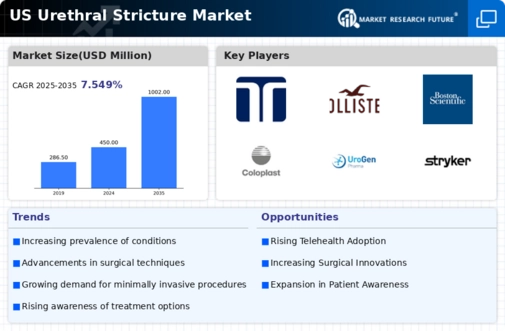Advancements in Surgical Techniques
Innovations in surgical techniques are transforming the urethral stricture market. The introduction of minimally invasive procedures, such as endoscopic urethrotomy and balloon dilation, has improved patient outcomes and reduced recovery times. These advancements not only enhance the effectiveness of treatments but also lower the overall costs associated with surgical interventions. For instance, the average cost of urethral stricture surgery can range from $5,000 to $15,000, depending on the complexity of the case. As these techniques become more widely adopted, they are expected to attract more patients seeking effective solutions, thereby stimulating growth in the urethral stricture market.
Rising Awareness of Urological Health
The urethral stricture market is also influenced by the rising awareness of urological health among the general population. Educational campaigns and initiatives by healthcare organizations are playing a pivotal role in informing individuals about the symptoms and risks associated with urethral strictures. As awareness increases, more patients are likely to seek medical attention, leading to earlier diagnosis and treatment. This trend is crucial, as timely intervention can significantly improve patient outcomes. The growing focus on urological health is expected to drive demand for various treatment modalities, thereby positively impacting the urethral stricture market.
Rising Incidence of Urethral Strictures
The urethral stricture market is experiencing growth due to the increasing incidence of urethral strictures among the male population in the US. Factors such as trauma, infections, and previous surgical procedures contribute to this rise. According to recent estimates, the prevalence of urethral strictures is approximately 1.5 to 2.0 cases per 1,000 males, indicating a significant patient population requiring treatment. This growing incidence drives demand for various treatment options, including surgical interventions and minimally invasive procedures, thereby expanding the urethral stricture market. As healthcare providers become more aware of the condition, the need for effective management strategies is likely to increase, further propelling market growth.
Growing Demand for Non-Invasive Treatment Options
There is a notable shift towards non-invasive treatment options within the urethral stricture market. Patients increasingly prefer treatments that minimize surgical risks and recovery times. Non-invasive methods, such as urethral dilation and the use of stents, are gaining traction due to their effectiveness and lower complication rates. The market for these alternatives is projected to grow, as they offer a viable solution for patients who may be hesitant to undergo traditional surgery. This trend reflects a broader movement in healthcare towards patient-centered care, which is likely to further enhance the urethral stricture market.
Increased Investment in Healthcare Infrastructure
The urethral stricture market is benefiting from increased investment in healthcare infrastructure across the US. Government initiatives aimed at improving healthcare access and quality are likely to enhance the availability of specialized urological services. This investment is crucial, as it supports the development of advanced diagnostic tools and treatment facilities, which are essential for managing urethral strictures effectively. With an estimated $4 trillion spent on healthcare in the US, a portion of this funding is directed towards urology, thereby fostering growth in the urethral stricture market. Enhanced infrastructure may lead to better patient outcomes and increased awareness of treatment options.




















Leave a Comment